An Interview with Artist Melissa Schappell
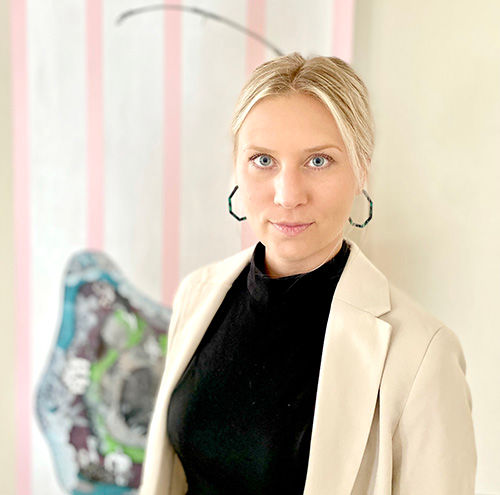
We are pleased to present this interview with Melissa Schappell, a nationally exhibiting visual artist currently residing in Virginia and Radford University graduate (MFA '20). Her mixed media artworks surrealistically fuse drawing, painting, printmaking, collage and/or assemblage to address personal and cultural issues in symbolic and satirical ways. She explores both personal and societal subject matter, often simultaneously. Two of her works were selected for the Collector's Edition at the Virginia Museum of Contemporary Art in 2023. You can learn more about her and her work at her website.
Let's start with the current Virginia Museum of Contemporary Art show, Collector's Edition. What can you tell us about the exhibition?
Collector's Edition is an exhibition that highlights and promotes the patrons of our region, their art collections, what inspires those selections, and the relationship between the artist and collector. It reflects on the human desire of wanting to collect meaningful things but in the context of what art means to them and what role it plays in their lives.
The space is curated in a way that highlights selected pieces from each patron's collections, so in viewing the work, you also get a sense of that patron's artistic voice. This is unique in that you get to view works through your own lens, but also somewhat through the eyes of the person who owns those works.
Tell us about the pieces you have in the exhibition.
Two of my pieces that are a part of the English family collection were selected amongst other regional, national, and globally recognized artists. The works "Three" and "Wisdom, It Is Not" were acquired by the family a few years apart at the Stockley Gardens Art Festival in Norfolk, Virginia. The works in this show address my observations and reflections on universal human experiences from both personal and broader lenses. They raise questions and suggest a visual narrative as it relates to gender roles, relationships and sexuality, politics or religion, mental health, chronic illness, and social constructs and systems.
"Three" was derived from an earlier series in 2017 that served as a personal form of art therapy with my OCD and anxiety issues, whereas "Wisdom, It Is Not," completed in 2022, draws broader comparisons to the female experience and healthcare through social and political structures. The mixed media works are directional and stage setting, but not conclusive so that the viewer is invited to bring their context to the narrative.
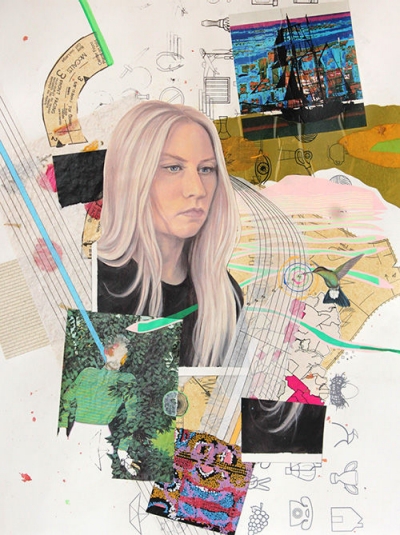
Let’s talk about your interest in mixed media art. What does it allow you to do that a single medium or technique might not? What challenges come with it?
Working with mixed media is a very stimulating creative process because of the constant problem solving and adaptation that takes place. Whether it is a technical challenge, compositional issue, or a conceptual one, each layer presents new and exciting possibilities that I have to work through. It is nearly impossible to predict the final result. There are frequent unexpected combinations or juxtapositions of imagery and materials that surface along the way and I enjoy the thrill of those moments.
This spontaneity of course is also the challenge, how can I embrace the unexpected and merge all of these mediums, yet still make it cohesive and sophisticated in its execution? Mixed media pushes me to hone multiple technical skills and methods as I ask myself "how can I make this work?"
Why do you think you are attracted to mixed media?
I have never been one to stay in a particular lane. I am a very tactile person who loves the hands-on qualities of the artmaking process and learning new things, so why choose one if I don't have to? I like that in the mixed media world there are less "rules" and less pretentiousness surrounding the medium. The idea of a "signature style" or staying with one medium for an entire career just because that is what you are recognized for feels very creatively stifling to me. Our world is in a constant state of change and fluctuations, and my process reflects that. The art is an experience more than a final product.
Can you tell us about your MFA here are Radford? What did you learn here that helped you as an artist? How did you change over time?
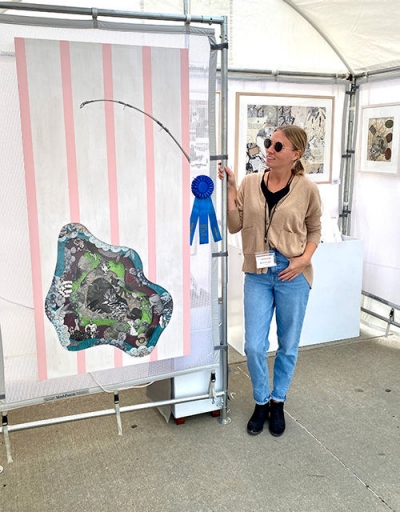
I spent two years at Radford getting my MFA from 2018-2020 and worked closely with Professors Brent Webb, Carlee Bradbury, and Rebecca Ghezi on my thesis work. Coming into the program, I was already working with mixed media and exploring themes of mental health, but my work was more didactic, tight, and flat in its layering approach. At Radford, I began researching the psychology of expectations which became the focus of my thesis body of work. Through the guidance of my mentors, I was able to experiment and take risks that inevitably led to my work being more sculptural, dimensional, loose, and interactive. I learned new techniques including screen printing, bookmaking, and light installations that I now incorporate into my continuing practice, but more importantly, I learned how to embrace my intuition and spontaneity within the artistic process.
What is your perspective on the art world today and how do you see your art operating within that?
It is an interesting time to be an artist because there are so many avenues and directions one can channel their creative energy. The art world is just a reflection of our society, our time and that which we value. The emphasis and dependence on technology and commodifying it is reflected in everything from AI to NFTs. Social and political issues of our time surrounding equality, race, bodily autonomy is reflected in work we are seeing in contemporary museums and community programming in addition to the increase of more diverse representation, (even though this has been an ongoing trend since the 70s and still has much room for improvement).
The art world still remains a bureaucratic system subject to influence by money and clout just as the academic world is. There will always be a certain "inner circle" that pulls certain strings. With that being said, artists have more options and control now in terms of how they want to make a career. We can diversify the methods by which our art is getting out there, and that is a blessing as long as you have the drive and confidence to execute.
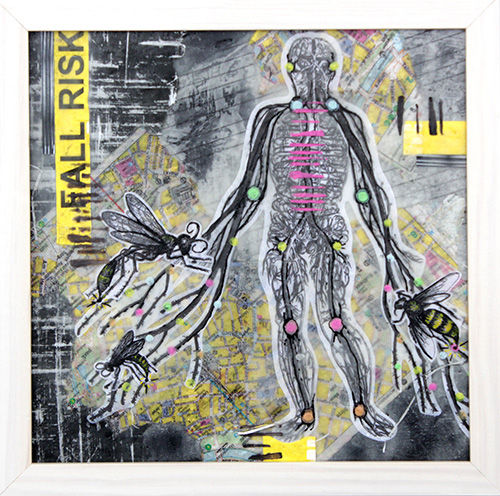
What advice do you have for young artists, particularly college students?
Well, from a practical and business-minded perspective, you need to be driven, good at self-learning, and humble enough to ask questions in the art world. Find your artist community and tribe and don't be afraid to trial and error your way through. Understand that you are running a business, that taxes are real, and that no one is going to hand you a manual of exactly how to do everything. Be open to opportunities and experiences you didn't plan for and don't let fear get in the way.
Now from a more artist-minded and conceptual perspective, my advice is to find your “why” and then stay true to it. Once you are selling work, it can be difficult to not compare yourself to others or get lost in what the patrons want. Some artists get lost in what sells, while others get lost in trying to be so unique and different, that it is actually creatively stifling for them. Continue to ask yourself what drives your own practice, why you create, what you are passionate about? Let that drive your practice. Find people who will challenge you and question you, so you can build your language around your practice and your "why."
I see a lot of work coming out of very well-established programs that feels redundant or derivative, because students got lost in conforming to a certain aesthetic of that program or what is popular in the auction world. On the other side of the coin, I have also seen artists whose work never changed at all throughout their entire program. Be open to critiques and different perspectives as a means to fuel experimentation and growth while finding a way to still stay true to yourself.
What advice would you have for them after they graduate?
Once you leave your program, don't be afraid to continue to change and evolve and experiment with your practice as you grow and evolve as a person. You will doubt yourself and you will feel vulnerable but, in the end, you have to know your worth, find your balance, and be authentic to your voice.
Don't let people make you feel insecure for having a "day job" or having to grind to make your passion a reality. Do whatever you have to do to be able to create. Life will get in the way, and your studio flow will constantly be getting interrupted, but keep at it the best you can and find your balance. You got this.
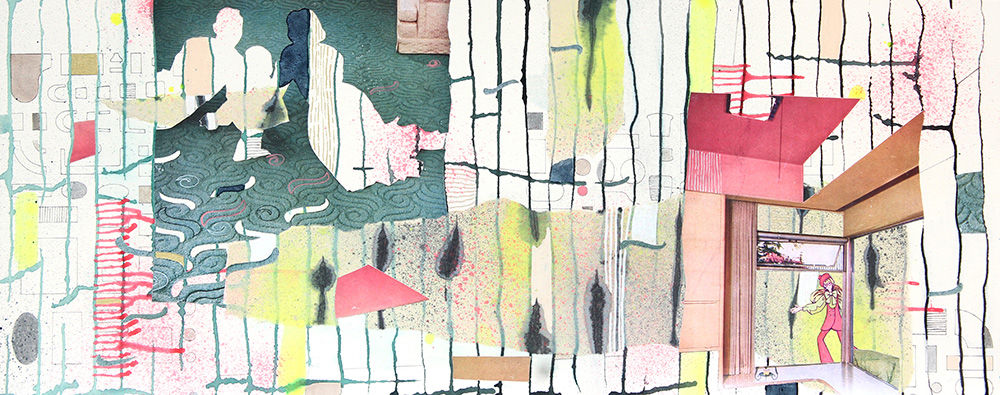
Title: Outside Looking In. Mixed Media and Collage: Chine-colle, Gouache, Watercolor, Pen and Ink, Alcohol Markers, Various Papers (12” x 30"). White Wash Wood Frame.